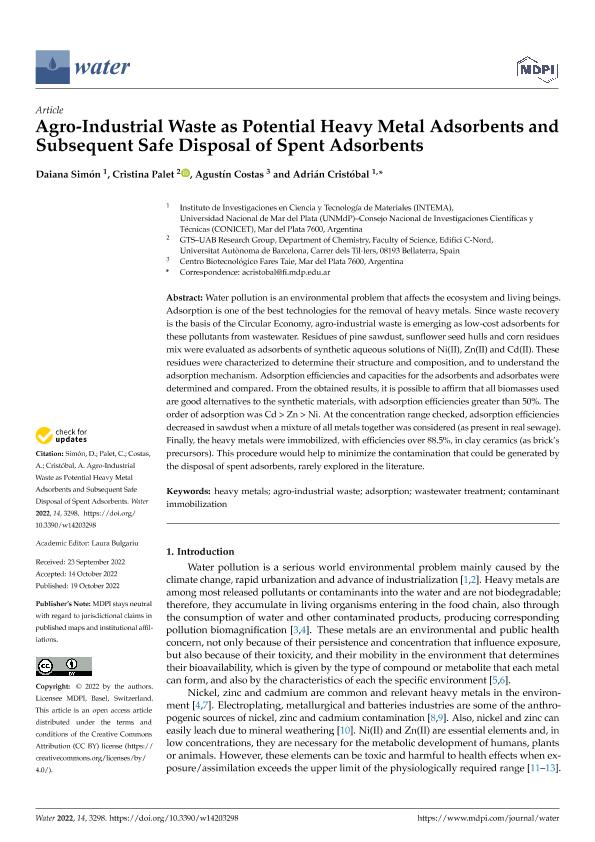Mostrar el registro sencillo del ítem
dc.contributor.author
Simón, Daiana Lucía

dc.contributor.author
Palet, Cristina
dc.contributor.author
Costas, Agustín
dc.contributor.author
Cristobal, Adrian Alberto

dc.date.available
2023-09-20T12:59:52Z
dc.date.issued
2022-10
dc.identifier.citation
Simón, Daiana Lucía; Palet, Cristina; Costas, Agustín; Cristobal, Adrian Alberto; Agro-Industrial Waste as Potential Heavy Metal Adsorbents and Subsequent Safe Disposal of Spent Adsorbents; Multidisciplinary Digital Publishing Institute; Water; 14; 20; 10-2022; 1-19
dc.identifier.issn
2073-4441
dc.identifier.uri
http://hdl.handle.net/11336/212252
dc.description.abstract
Water pollution is an environmental problem that affects the ecosystem and living beings. Adsorption is one of the best technologies for the removal of heavy metals. Since waste recovery is the basis of the Circular Economy, agro-industrial waste is emerging as low-cost adsorbents for these pollutants from wastewater. Residues of pine sawdust, sunflower seed hulls and corn residues mix were evaluated as adsorbents of synthetic aqueous solutions of Ni(II), Zn(II) and Cd(II). These residues were characterized to determine their structure and composition, and to understand the adsorption mechanism. Adsorption efficiencies and capacities for the adsorbents and adsorbates were determined and compared. From the obtained results, it is possible to affirm that all biomasses used are good alternatives to the synthetic materials, with adsorption efficiencies greater than 50%. The order of adsorption was Cd > Zn > Ni. At the concentration range checked, adsorption efficiencies decreased in sawdust when a mixture of all metals together was considered (as present in real sewage). Finally, the heavy metals were immobilized, with efficiencies over 88.5%, in clay ceramics (as brick’s precursors). This procedure would help to minimize the contamination that could be generated by the disposal of spent adsorbents, rarely explored in the literature.
dc.format
application/pdf
dc.language.iso
eng
dc.publisher
Multidisciplinary Digital Publishing Institute
dc.rights
info:eu-repo/semantics/openAccess
dc.rights.uri
https://creativecommons.org/licenses/by-nc-sa/2.5/ar/
dc.subject
ADSORPTION
dc.subject
AGRO-INDUSTRIAL WASTE
dc.subject
CONTAMINANT IMMOBILIZATION
dc.subject
HEAVY METALS
dc.subject
WASTEWATER TREATMENT
dc.subject.classification
Otras Ingeniería de los Materiales

dc.subject.classification
Ingeniería de los Materiales

dc.subject.classification
INGENIERÍAS Y TECNOLOGÍAS

dc.title
Agro-Industrial Waste as Potential Heavy Metal Adsorbents and Subsequent Safe Disposal of Spent Adsorbents
dc.type
info:eu-repo/semantics/article
dc.type
info:ar-repo/semantics/artículo
dc.type
info:eu-repo/semantics/publishedVersion
dc.date.updated
2023-06-23T16:36:09Z
dc.journal.volume
14
dc.journal.number
20
dc.journal.pagination
1-19
dc.journal.pais
Suiza

dc.description.fil
Fil: Simón, Daiana Lucía. Consejo Nacional de Investigaciones Científicas y Técnicas. Centro Científico Tecnológico Conicet - Mar del Plata. Instituto de Investigaciones en Ciencia y Tecnología de Materiales. Universidad Nacional de Mar del Plata. Facultad de Ingeniería. Instituto de Investigaciones en Ciencia y Tecnología de Materiales; Argentina
dc.description.fil
Fil: Palet, Cristina. Universitat Autònoma de Barcelona; España
dc.description.fil
Fil: Costas, Agustín. Fares Taie Instituto de Análisis; Argentina
dc.description.fil
Fil: Cristobal, Adrian Alberto. Consejo Nacional de Investigaciones Científicas y Técnicas. Centro Científico Tecnológico Conicet - Mar del Plata. Instituto de Investigaciones en Ciencia y Tecnología de Materiales. Universidad Nacional de Mar del Plata. Facultad de Ingeniería. Instituto de Investigaciones en Ciencia y Tecnología de Materiales; Argentina
dc.journal.title
Water
dc.relation.alternativeid
info:eu-repo/semantics/altIdentifier/url/https://www.mdpi.com/2073-4441/14/20/3298/htm
dc.relation.alternativeid
info:eu-repo/semantics/altIdentifier/doi/https://doi.org/10.3390/w14203298
Archivos asociados
